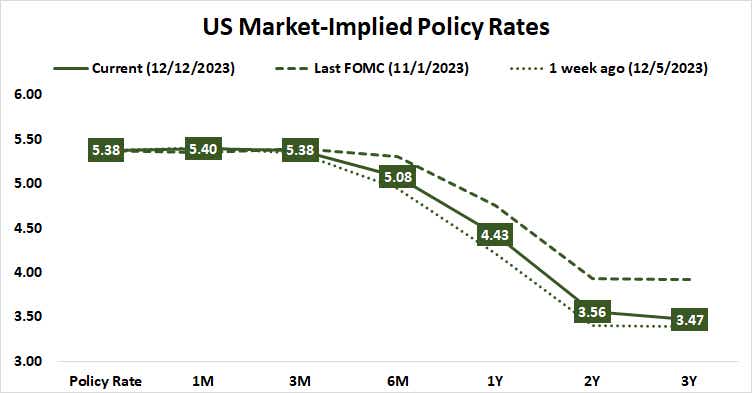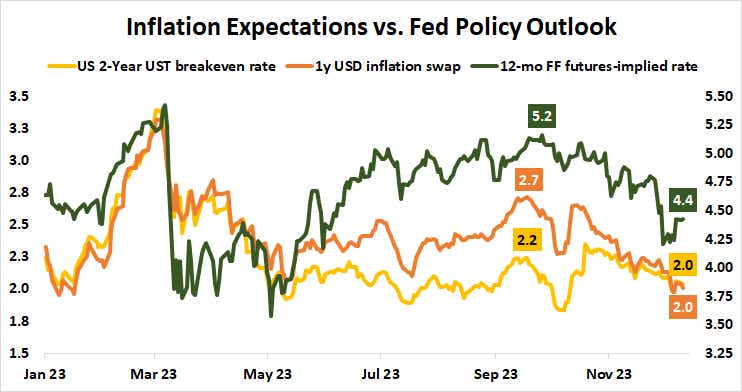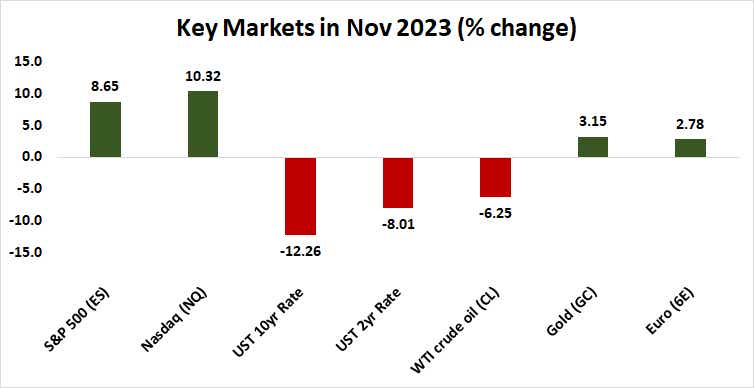Stocks May Retreat Even as the Fed Endorses Rate Cut Bets: FOMC Preview

Stocks May Retreat Even as the Fed Endorses Rate Cut Bets: FOMC Preview
By:Ilya Spivak
Why stocks may turn lower as the Federal Reserve inches closer to interest rate cuts
- All eyes on the Federal Reserve for the final FOMC policy meeting of 2023.
- Officials may aim to signal rate cuts without endorsing ultra-dovish excess.
- Markets in corrective mode may deflate stocks and bonds, lift U.S. dollar.
Financial markets have been consumed with speculation about Federal Reserve monetary policy since the global economy emerged from the COVID-19 pandemic with inflation rates unseen in half a century.
As 2023 draws to a close, markets are preparing to turn the page on one chapter in this story and begin another.
At its last meeting of the year, the U.S. central bank’s policy-setting Federal Open Market Committee (FOMC) looks set to bookend the blistering interest rate hike cycle that it began to signal in June 2021 and execute in March 2022. The markets are convinced that rates will remain unchanged, with a round of cuts to follow in 2024.
Fed rate cuts: how soon, and how much?
The main questions are when the cuts will begin, and how many of them are on the menu. As it stands, the first 25-basis-point (bps) reduction is priced in to appear no later than May. Four such moves are already reflected in markets, along with 47% probability of a fifth. That implies a rate reduction of 1.00-1.25% next year.

How markets react to the Fed meeting’s outcome depends on whether it forces revisions to this view. Updated economic and interest rate forecasts as well as a press conference with Fed Chair Jerome Powell are in focus. Officials deftly shaped policy outcomes through these channels without overtly adjusting rates in September and November.
November saw a sharp dovish shift in monetary policy expectations. The markets have seemingly learned to look through policymakers’ familiar well-rehearsed disclaimers about ensuring that inflation is contained and their readiness to hike rates if need be. Instead, they’ve focused on incremental dovish tweaks in Fed guidance.
The FOMC two-step: stocks at risk, dollar may rise
The current situation looks encouraging for Powell and his colleagues. Last month’s decline in expected interest rates was accompanied by falling inflation expectations priced into the bond and swap markets. This suggests the markets have been convinced that disinflation will continue even as the Fed pivots to addressing slowing economic growth.

Opting against any dovish signaling may push markets to see November’s moves as overdone. That could see Treasury yields and the U.S. dollar jump move sharply, amounting to an unwelcome tightening of financial conditions. Sounding too eager to cut would have the opposite effect and risk unhinging inflation expectations anew.
Finding the middle ground may be a two-pronged affair. That might mean removing the explicit tightening bias from the policy statement and tinkering with the forecasts to envision lower inflation and a higher jobless rate next year, then sending a hawkish-sounding Powell to the press conference.
Getting this two-step right may amount to a “buy the rumor, sell the fact” response from the markets. If November was the “buy” part of investors’ reckoning with the Fed’s turn to easing, this FOMC meeting may trigger the “sell” part. That could bring stocks, bonds and gold prices lower as yields and the dollar correct higher, if only in the near term.

Ilya Spivak, tastylive head of global macro, has 15 years of experience in trading strategy, and he specializes in identifying thematic moves in currencies, commodities, interest rates and equities. He hosts Macro Money and co-hosts Overtime, Monday-Thursday. @Ilyaspivak
For live daily programming, market news and commentary, visit tastylive or the YouTube channels tastylive (for options traders), and tastyliveTrending for stocks, futures, forex & macro.
Trade with a better broker, open a tastytrade account today. tastylive, Inc. and tastytrade, Inc. are separate but affiliated companies.
Options involve risk and are not suitable for all investors. Please read Characteristics and Risks of Standardized Options before deciding to invest in options.
tastylive content is created, produced, and provided solely by tastylive, Inc. (“tastylive”) and is for informational and educational purposes only. It is not, nor is it intended to be, trading or investment advice or a recommendation that any security, futures contract, digital asset, other product, transaction, or investment strategy is suitable for any person. Trading securities, futures products, and digital assets involve risk and may result in a loss greater than the original amount invested. tastylive, through its content, financial programming or otherwise, does not provide investment or financial advice or make investment recommendations. Investment information provided may not be appropriate for all investors and is provided without respect to individual investor financial sophistication, financial situation, investing time horizon or risk tolerance. tastylive is not in the business of transacting securities trades, nor does it direct client commodity accounts or give commodity trading advice tailored to any particular client’s situation or investment objectives. Supporting documentation for any claims (including claims made on behalf of options programs), comparisons, statistics, or other technical data, if applicable, will be supplied upon request. tastylive is not a licensed financial adviser, registered investment adviser, or a registered broker-dealer. Options, futures, and futures options are not suitable for all investors. Prior to trading securities, options, futures, or futures options, please read the applicable risk disclosures, including, but not limited to, the Characteristics and Risks of Standardized Options Disclosure and the Futures and Exchange-Traded Options Risk Disclosure found on tastytrade.com/disclosures.
tastytrade, Inc. ("tastytrade”) is a registered broker-dealer and member of FINRA, NFA, and SIPC. tastytrade was previously known as tastyworks, Inc. (“tastyworks”). tastytrade offers self-directed brokerage accounts to its customers. tastytrade does not give financial or trading advice, nor does it make investment recommendations. You alone are responsible for making your investment and trading decisions and for evaluating the merits and risks associated with the use of tastytrade’s systems, services or products. tastytrade is a wholly-owned subsidiary of tastylive, Inc.
tastytrade has entered into a Marketing Agreement with tastylive (“Marketing Agent”) whereby tastytrade pays compensation to Marketing Agent to recommend tastytrade’s brokerage services. The existence of this Marketing Agreement should not be deemed as an endorsement or recommendation of Marketing Agent by tastytrade. tastytrade and Marketing Agent are separate entities with their own products and services. tastylive is the parent company of tastytrade.
tastyfx, LLC (“tastyfx”) is a Commodity Futures Trading Commission (“CFTC”) registered Retail Foreign Exchange Dealer (RFED) and Introducing Broker (IB) and Forex Dealer Member (FDM) of the National Futures Association (“NFA”) (NFA ID 0509630). Leveraged trading in foreign currency or off-exchange products on margin carries significant risk and may not be suitable for all investors. We advise you to carefully consider whether trading is appropriate for you based on your personal circumstances as you may lose more than you invest.
tastycrypto is provided solely by tasty Software Solutions, LLC. tasty Software Solutions, LLC is a separate but affiliate company of tastylive, Inc. Neither tastylive nor any of its affiliates are responsible for the products or services provided by tasty Software Solutions, LLC. Cryptocurrency trading is not suitable for all investors due to the number of risks involved. The value of any cryptocurrency, including digital assets pegged to fiat currency, commodities, or any other asset, may go to zero.
© copyright 2013 - 2025 tastylive, Inc. All Rights Reserved. Applicable portions of the Terms of Use on tastylive.com apply. Reproduction, adaptation, distribution, public display, exhibition for profit, or storage in any electronic storage media in whole or in part is prohibited under penalty of law, provided that you may download tastylive’s podcasts as necessary to view for personal use. tastylive was previously known as tastytrade, Inc. tastylive is a trademark/servicemark owned by tastylive, Inc.